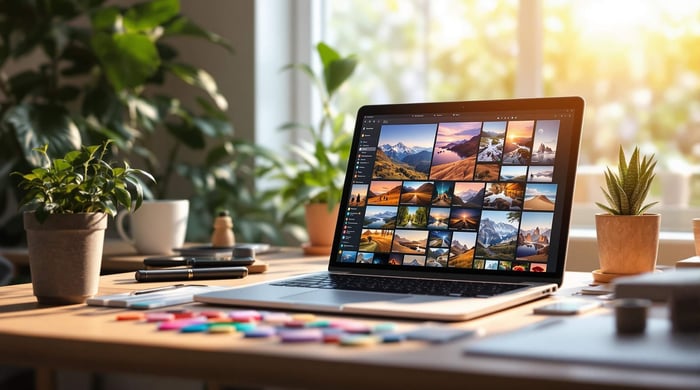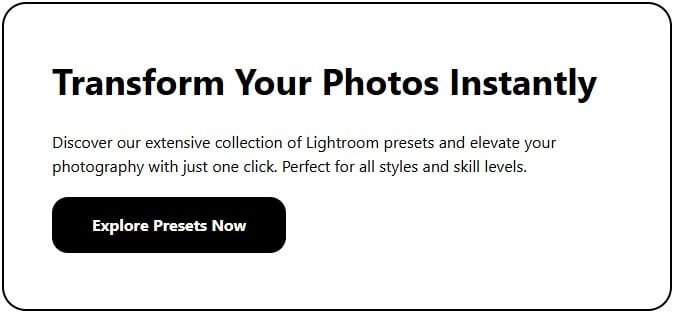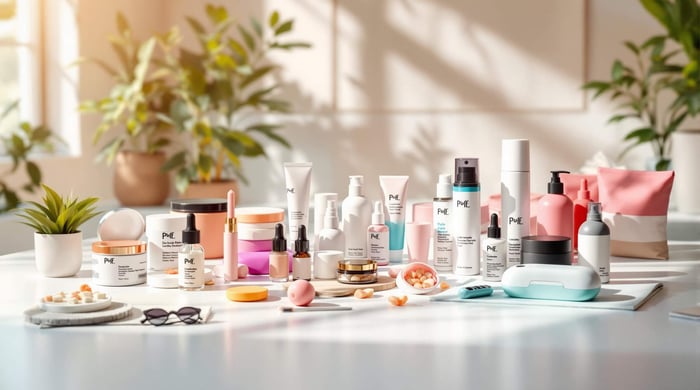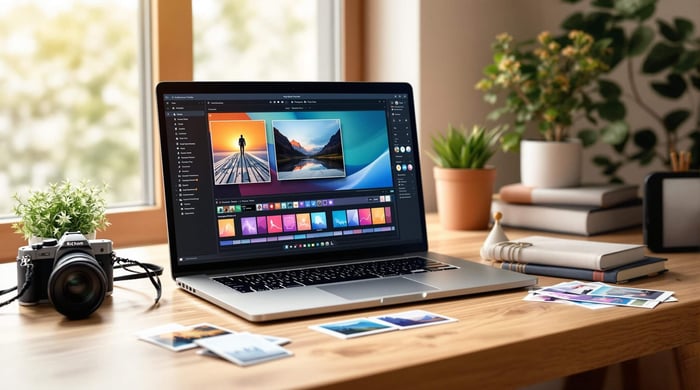How to Use Presets to Build Your Photography Portfolio
Presets can save photographers time, ensure a consistent style, and simplify editing workflows. They are pre-saved adjustments in editing software like Lightroom, applied with one click to transform photos. Key benefits include:
- Time-Saving: Speeds up editing by completing 80–90% of the process.
- Style Consistency: Creates a unified look across your portfolio.
- Streamlined Workflow: Useful for managing large image sets efficiently.
However, presets are just starting points. They need fine-tuning for specific lighting, subjects, or shooting conditions. The article covers how to choose, customize, and apply presets effectively for different photography styles like portraits, landscapes, or product shoots.
Quick Tip: Always test presets across various lighting conditions and tweak settings like white balance or exposure for the best results.
How to Make Lightroom Presets Work with Your Photos
Preset Basics
Grasping these essentials will help you choose and tweak presets to create a polished and unified portfolio.
What is a Preset?
A preset is a saved set of photo-editing adjustments in Lightroom, designed to transform images with just one click. These "recipes" modify elements like exposure, contrast, and color balance, and they work seamlessly on both desktop and mobile versions of the software.
Key Preset Advantages
- Saves Time: Presets can complete 80–90% of the editing process in a single click, significantly reducing the time spent on each photo [3].
- Consistency in Style: They ensure your edits look uniform across your portfolio, boosting brand recognition and building trust with clients.
- Streamlined Workflow: You can batch-apply presets during import, making them especially useful when dealing with large sets of images.
Common Preset Challenges
Presets aren't without their drawbacks:
- Over-Reliance: Photographer Jonathan Reid warns, > "With presets and actions, you stop thinking for yourself and you follow a look that someone else has designed" [5]. While presets are helpful, it's crucial to hone your own editing skills.
- Image-Specific Adjustments: Presets are starting points, not complete solutions. Photos often require tweaks to settings like white balance and exposure to suit their unique characteristics [1].
| Challenge | Solution |
|---|---|
| Variable Lighting | Adjust exposure and white balance after applying the preset |
| Different Subjects | Refine skin tones for portraits or boost greens for landscapes |
| Mixed Shooting Conditions | Create separate preset versions for indoor and outdoor environments |
To get the most out of pre-sets, photographers should develop a clear style profile. This includes defining your preferred aesthetic, fine-tuning temperature and tint settings, and making specific adjustments for recurring elements like skin tones and greenery [4].
Up next, explore how to pick the right pre-sets to suit your portfolio and overcome these challenges.
Selecting Portfolio Presets
Presets by Photo Type
Each photography style benefits from specific preset characteristics. For example, photographers in the Pacific Northwest often use moody pre-sets to enhance overcast skies and complement earthy tones [7]. Meanwhile, those shooting in the Southwest prefer airy pre-sets to soften the effects of harsh sunlight [7].
| Photography Style | Suggested Preset Type | Key Features |
|---|---|---|
| Portrait/Wedding | Light & airy, warm tones | Keeps skin tones natural |
| Landscape | High contrast, vibrant | Boosts greens and blues |
| Boudoir | Dark and moody, film-like | Deep blacks, muted highlights |
| Product/Lifestyle | True-to-color, clean | Ensures product accuracy |
| Newborn | Soft & natural | Reduces red/yellow undertones |
These suggestions help align pre-sets with the desired aesthetic of your portfolio.
Preset Pack Review Guide
When reviewing preset packs, focus on these aspects:
- How well they handle the warmth of indoor shots versus the cool tones of outdoor images.
- The intensity of highlights and saturation.
- Skin tone accuracy and overall temperature balance [6].
"Knowing your photo editing style before purchasing presets can really streamline your workflow and ensure you're getting presets that match your vision."
– Sara Lou, Lou & Marks Presets [7]
After narrowing down options, test pre-sets systematically to see how they perform with your specific needs.
Sample Testing Methods
Use structured testing tools like Compare Pre-sets to evaluate options. Start by selecting your camera model and genre, then test pre-sets on sample images through blind comparisons [8].
For a deeper dive, use PixelPeeper's Lightroom Preset Viewer to preview XMP effects, analyze preset adjustments, and compare results across different image types [9].
"The problem that I'm trying to solve is that photographers typically buy presets just guessing that they will like them. Sometimes they don't look great on their photos, or their camera, and they don't live up to the expectations built up from seeing the amazing photos that the preset makers show off as samples."
– Steven Inge, Photographer and Creator of Compare Presets [8]
Before committing to a preset pack, test them under various lighting conditions:
- Golden hour: Look for moderate saturation settings.
- Overcast weather: Try warmer pre-sets for natural skin tones.
- Bright sunlight: Choose softer pre-sets to balance contrast.
- Low-light scenes: Opt for pre-sets that enhance shadow details [7].
Preset Customization Steps
Basic Preset Modifications
Getting started with pre-sets means understanding the key adjustments:
- White Balance: Pick a preset that matches your scene. For example, use Daylight for the golden hour.
- Exposure Triangle: Adjust these settings based on your subject:
- Portraits: Aperture f/1.8–f/5.6, shutter speed ≥1/100s, ISO 100–1600.
Situation-Specific Adjustments
Different lighting conditions call for tailored adjustments to keep your portfolio consistent. For instance, when capturing landscapes, tweak your base settings based on the light:
| Lighting Condition | White Balance | Key Adjustments |
|---|---|---|
| Bright Daylight | Daylight | Lower highlights, raise shadows |
| Overcast | Cloudy | Boost contrast, adjust white point |
| Golden Hour | Custom (5500K) | Enhance warm tones, reduce saturation |
| Indoor Tungsten | 2800K | Correct color cast, adjust tint |
Always start with RAW files. They give you more room to adjust without losing quality [12].
Building Your Style
Creating a consistent look across your portfolio involves fine-tuning pre-sets to suit your preferences.
"Once you've applied the preset, you can adjust the settings manually to make it your own. It's sort of like trying and altering different recipes until you find a version of the dish that is personalized and perfect for you." [10]
Here’s how to refine your style:
- Apply a preset.
- Adjust the intensity slider [11].
- Save variations for different lighting conditions.
- Organize your pre-sets by style [12].
For portraits, use the HSL panel to tweak specific color ranges while keeping the preset’s overall look intact.
Portfolio-Wide Preset Use
Multi-Genre Preset Tips
Michaela Luyt shares, "Every preset should be adapted for each shoot's lighting and elements" [13].
When working across different genres, focus on these key adjustments:
| Genre | Initial Preset Adjustments | Style Maintenance Tips |
|---|---|---|
| Portraits | Adjust HSL for skin tones | Keep warm undertones consistent |
| Landscapes | Boost color vibrancy | Maintain highlight recovery settings |
| Events | Balance exposure range | Preserve shadow detail across venues |
| Product | Fine-tune clarity | Standardize white balance approach |
Once you've tailored pre-sets for the genre, refine each image to highlight its unique qualities.
Image-Specific Tweaks
Individual images often need additional fine-tuning.
"Presets have since saved me a lot of time and effort when editing images. Instead of manually adjusting every setting, I apply the desired look then refine specifics" [3].
Key areas to focus on:
- White Balance: Match the lighting conditions for natural tones.
- Exposure: Adjust based on the brightness of the scene.
- Color Grading: Use selective edits to enhance specific areas.
These adjustments ensure each image contributes to a cohesive, polished portfolio.
Style Consistency Tips
A consistent editing style strengthens your brand identity.
- Document your core editing principles: Define the techniques and preferences that represent your style.
- Create preset variations: Tailor them for different lighting scenarios to maintain consistency.
- Regularly review your portfolio: Ensure all images align with your desired aesthetic.
"Capturing the moment but not overshadowing it with too much editing - that's the balance you need to find" [13].
Preset Settings Guide
Here’s a quick reference for preset settings tailored to different photography scenarios. Use this table to kickstart your editing process:
| Photo Type | Preset Style | Key Adjustments |
|---|---|---|
| Indoor Portraits | Warm Natural | - Set color temperature to 5000–5500K [14] - Reduce contrast - Soften shadows |
| Outdoor Portraits | Light & Airy | - Lower highlight levels - Increase black levels for softer contrast [15] |
| Landscape | Vibrant Dynamic | - Fine-tune green tones in HSL [15] - Boost clarity - Balance exposure |
| Low-Light Events | Clean Balanced | - Apply noise reduction - Recover shadow details - Correct white balance |
| Product | Crisp Commercial | - Recover highlights - Enhance clarity - Use a neutral color temperature |
Tips for Using Presets Effectively
- Start with a neutral color temperature (around 5000–5500K) for a balanced base.
- Fine-tune exposure settings:
- Soften highlights for better detail.
- Raise black levels to create a gentle contrast.
- Adjust green tones through HSL sliders for a more natural look [15].
Conclusion
Pre-sets can be a game-changer for creating a standout portfolio and streamlining workflows, particularly for large-scale projects or frequent client work [16]. They not only save time but also help establish a consistent and recognizable style.
Photographer Danielle Joy emphasizes the importance of this consistency:
"As a photographer, your style is your brand. Custom presets help ensure that every image you deliver aligns with your vision" [2].
In fact, research shows that 80% of consumers are more likely to engage with businesses offering personalized experiences [18]. Professional photographer Michelle Grace shares a similar perspective:
"For me, Pretty Presets has been central to saving time and consistently delivering beautiful art, preserving memories for countless families" [17].
However, pre-sets alone aren't enough. Their true potential lies in how you adapt and refine them. To get the most out of pre-sets, focus on these key practices:
- Tailor pre-sets to reflect your unique style.
- Maintain consistency while adjusting for different shooting conditions.
- Combine automation with manual adjustments for precision.
When used thoughtfully, pre-sets can help you create a cohesive, professional portfolio that resonates with your audience and showcases your artistic vision. Take the time to refine your approach, and you'll find that pre-sets can be a powerful tool for both creativity and efficiency.



.png)




